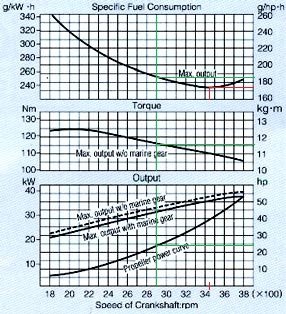When you wrotte
You're comparing two very different boats. Different shape hulls, different lengths, different widths. I assume different waterlines and yours is longer and therefore has a faster displacement speed. Then don't even know the type engines or vintage and that could be another factor. Definitely an apples and oranges comparison.
I will agree that in some situations twins get nearly the same fuel consumption but in others they consume more.
"twins get nealy"
for example our boat :
- at 8,3 nds on one engine need 1,46 lt per nm
- at 8 nds on two engine need 1,14 lt per nm
It depends also of the type of engine (for example some new engines at 1500rpm needs 0,185 lt per hp and some at 1500rpm needs 0,155 lt per hp) and at witch rpm each engine need to "produce" the needed hp.
I am not clear !?

It is normal ...I am French !!.
example of our consumption :
- sur un moteur à 1400 t/mn : 6,6 nds et consommation de 0,61 lt au mille.
- sur un moteur à 1500 t/mn : 7 nds et consommation de 0,81 lt au mille.
- sur un moteur à 1600 t/mn : 7,4 nds et consommation de 0,92 lt au mille.
- sur un moteur à 1800 t/mn : 8,3 nds et consommation de 1,46 lt au mille.
- sur deux moteurs à 1780 t/mn : 8 nds et consommation de 1,14 lt au mille.
- sur deux moteurs à 1850 t/mn : 9,80 nds et consommation de 1,78 lt au mille.
If (for the next boat !!) we decide to have just one engine we will chose an engine able to produce enough power at the best point of consumption (for Perkins or Deutz around 1500 rpm) to reach our "normal" cruising speed.

 Pun intended!
Pun intended!
 You can buy lots of ECUs, injectors and fuel for that much money. :lol:
You can buy lots of ECUs, injectors and fuel for that much money. :lol: 